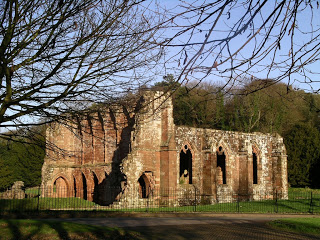Medieval History

Ulster , Dublin
- The Silverdale Hoard, Museum Of Lancashire, Preston
From Dr. Fiona Edmonds, Senior Lecturer in Celtic History Readers of the ASNC blog will no doubt be interested in the Silverdale Hoard, which was discovered by a metal-detectorist in 2011. The appropriately named Silverdale is located on the edge of...
- Urgent Call For Repairs To Medieval Churches In Honing And Crostwight
An unusual series of medieval paintings depicting the seven deadly sins could be lost from the walls of All Saints Church at Crostwight near North Walsham unless £150,000 can be found to re thatch the leaky roof, re-render the walls and repair the exterior...
- Medieval Treasures Discovered In English Abbey
An archaeological investigation at Furness Abbey in northwest England has uncovered the grave of an abbot, which includes an extremely rare medieval silver-gilt crozier and bejewelled ring. The grave, which could date back to the 12th century, was uncovered...
- Was St Patrick A Slave-trading Roman Official Who Fled To Ireland?
The classic account of St Patrick?s life tells us that he was abducted from Western Britain in his teens and forced into slavery in Ireland for six years before escaping, during which time his faith developed. However, a new article looking at Patrick?s...
- Viking Silver Coin Hoard Discovered In Northern England
A Viking treasure hoard of silver coins has been discovered in the northern English country of Cumbria. The find is being billed as ?the missing link? by experts who say it is the long-awaited significant evidence of 9th and 10th Century AD material culture...
Medieval History
Medieval Furness: Texts and Contexts
Dr Fiona Edmonds writes:
I am writing to tell you about the AHRC-funded project ?Hagiography at the Frontiers: Jocelin of Furness and Insular Politics? and the associated conference ?Medieval Furness: Texts and Contexts?, which will take place on 8th July, 2011. I am the Co-investigator on the project; the other participants are Dr Clare Downham, University of Liverpool
The aims of the project are threefold: to bring forth editions and translations of two texts (Jocelin?s Lives of Patrick and Helena); to conduct research into the cultural context in which Jocelin was working; and to further knowledge of Jocelin?s work amongst the general public, particularly in Cumbria and North Lancashire. The writings of Jocelin of Furness have not attracted a great deal of scholarship, although there has been a resurgence of interest in his work recently, as witnessed by Dr Helen Birkett?s book The Saints? Lives of Jocelin of Furness (Woodbridge: Boydell and Brewer, 2010). The study of Jocelin?s work has been made more difficult by the absence of satisfactory published editions of certain texts, notably the Life of St Patrick. Jocelin?s writings are, however, of great interest to scholars of twelfth-century Britain and Ireland

Furness Abbey (image from Wikimedia commons)
One of the most interesting features of Jocelin?s work is his interest in the Celtic world: Jocelin not only wrote a Life of Patrick, but also a Life of Kentigern (a North British saint and the patron of Glasgow Melrose in the Scottish Borders, a leading monastic reformer in northern England Ireland Ireland and Man.
The project?s main themes will be explored in our day conference ?Medieval Furness: Texts and Contexts?. The conference will take place at the Abbey House hotel, Barrow-in-Furness ; the programme is copied below. The conference is supported by the University of Liverpool and the Department of Anglo-Saxon, Norse, and Celtic, University of Cambridge
Programme:
9.00 Registration
9.30 Opening remarks: Keith Stringer (Lancaster University
9.45 Janet Burton (University of Wales
Furness, Savigny and the Cistercian World
10.15 Hugh Doherty (University of Oxford
The twelfth-century benefactors and enemies of Furness Abbey
10.45 Tea/Coffee
11.15 John Reuben Davies (University of Glasgow
The Life of St Waldef, abbot of Melrose
11.45 Marie-Therese Flanagan (Queen?s University, Belfast
The Life of St Patrick, patron saint of Ireland
12.15 Seán Duffy (Trinity College Dublin
12.45 Lunch
2.00 Helen Birkett (Edinburgh University
Jocelin and the literary legacy of Furness Abbey
2. 30 Jason Wood (Heritage Consultancy Services)
Furness Abbey: art, literature and tourism
3.00 Closing Remarks: Richard Sharpe (University of Oxford
3.30 Visit to Furness Abbey
6pm Conference dinner
- The Silverdale Hoard, Museum Of Lancashire, Preston
From Dr. Fiona Edmonds, Senior Lecturer in Celtic History Readers of the ASNC blog will no doubt be interested in the Silverdale Hoard, which was discovered by a metal-detectorist in 2011. The appropriately named Silverdale is located on the edge of...
- Urgent Call For Repairs To Medieval Churches In Honing And Crostwight
An unusual series of medieval paintings depicting the seven deadly sins could be lost from the walls of All Saints Church at Crostwight near North Walsham unless £150,000 can be found to re thatch the leaky roof, re-render the walls and repair the exterior...
- Medieval Treasures Discovered In English Abbey
An archaeological investigation at Furness Abbey in northwest England has uncovered the grave of an abbot, which includes an extremely rare medieval silver-gilt crozier and bejewelled ring. The grave, which could date back to the 12th century, was uncovered...
- Was St Patrick A Slave-trading Roman Official Who Fled To Ireland?
The classic account of St Patrick?s life tells us that he was abducted from Western Britain in his teens and forced into slavery in Ireland for six years before escaping, during which time his faith developed. However, a new article looking at Patrick?s...
- Viking Silver Coin Hoard Discovered In Northern England
A Viking treasure hoard of silver coins has been discovered in the northern English country of Cumbria. The find is being billed as ?the missing link? by experts who say it is the long-awaited significant evidence of 9th and 10th Century AD material culture...
